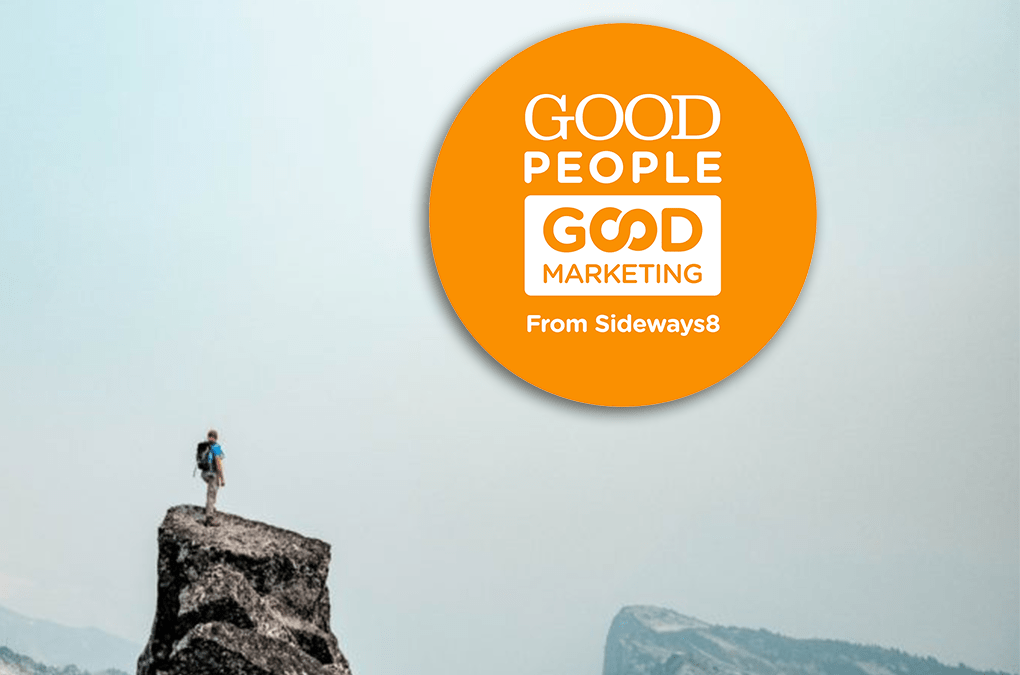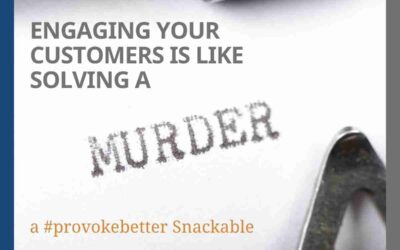“People don’t give to need, they give to success,” and other tips for nonprofit video marketing strategy.
provokebetter‘s Whitney Hahn was featured on the Good People, Good Marketing Podcast, hosted by Adam Walker from Sideways8 Interactive. In this interview, Whitney gets up on her soapbox and talks about what’s new, exciting, and wonderful in the world of video marketing, and how nonprofit organizations should use it to win people over and earn their donations. Hear what she says and how it could change your life and the way you market.
What is working well in digital marketing?
Whitney: My favorite tool for digital marketing is video marketing. That is what we specialize in at my company and we’ve been doing that since actually the year before youtube.com was registered as a domain name. So we’ve been involved in creating video marketing since before video marketing was a thing online. Our roots are in broadcast and I really loved how availability and consumption of video has increased because we think it’s the next best thing to be in there.
You can hear it, you can see it move, you can listen to the laughter of somebody enjoying a theme park or you can hear the crack in somebody’s voice as they’re sharing an emotional story. That’s really hard to capture in text and photos no matter how great you might be as a copywriter or a photojournalist. And so I’m super excited about the way that people are creating videos, consuming videos, sharing them, commenting on them, engaging with it; and we’re really seeing it work well even for the nonprofit clients that we work with in our own backyard.
Adam: Wow, that’s fantastic. I agree with you; I think video is on the rise. I mean, it seems to me that Facebook’s making some really big plays towards video. Obviously, Instagram has made some plays for its video recently as well. I mean, is there any particular aspect or platform or tool that has you particularly excited at this moment in time?
Whitney: Oh, man, there are so many. I think the platform, honestly, Adam, is a little less important than the planning. And so, like as we work with our nonprofit clients, for example, we know that when you’re fundraising and friendraising, people don’t give to need, they give to success.
And so the first thing that we talk about is how do you demonstrate to your audience, in whatever format you might be communicating with them, how do you demonstrate the success that you have on behalf of your clients? How do you show that you’re good stewards of the money that you’re asking for in donations? Sharing that impact story over and over again, I think, is critical. And again, video is a great way to do that. I don’t think it really matters tremendously if it’s Instagram or Facebook or your website or the presentation that you’re giving for your local civic organization.
“If the strategy’s missing, it really doesn’t matter what else is there.” – Whitney
Adam: That’s true. That’s true. And that’s true not just for video. That’s true for almost everything, but you’re right. I mean, if you don’t know what story you’re trying to tell them, you’re just throwing together a nice little video, like we were talking about offline previous to this recording. It’s pointless, right? If it’s a video that says nothing, there’s no reason to have it, right?
Whitney: You have to distinguish yourself within the marketplace. You have to show how you’re different, how you’re achieving the successes within your organization and your larger community. And I hate conversations that start with, “Okay, we’ve got this idea, a picture of this opening shot of…” and they start to explain the visual. And I call a timeout and I say, “Whoa … how does this fit into your larger message?” The last thing I want to do is build this—I’m using air quotes here, Adam—cool video, that really says nothing, does nothing, has no clear call to action and does zero for your conversions. Like that just sickens my marketer’s heart. I don’t like that. It’s unhappy Whitney when that’s happened.
Adam: Well, I mean, it’s like what I was telling you before this podcast. I mean, I watched the video earlier today. It’s a two-minute long video. It literally said nothing and I finished the video and I was actually legitimately angry that I had just watched this video that just said nothing. It’s like, that was pointless, like completely insanely pointless. So don’t do that.
Whitney: And it may have been beautiful HD footage. It may have had a lovely soundtrack to it, but the strategy was missing. It didn’t — yeah, I get you.
Adam: Yes. Even with good voiceovers with lots of different people all saying nothing. And I was just like, “What is this? This is crazy.” So yeah, we don’t want that. That’s bad. I like that, if the strategy is missing, there’s just no reason to do it at all. I totally agree with you on that.
Whitney: Yes. You have to lead with strategy.
What is not working well in digital and video marketing?
Adam: Question number two: Related to digital marketing, can you tell us something that has not worked well that we can learn from?
Whitney: Early on in my career, way way back in the wayback machine, I would let the client dictate, “Well, I’ve got this great idea because everybody’s creative.” Now, I agree that everybody’s creative but not everybody’s right and that does include me. I will say, “I’m an idea generator and not all of them are good, but we’re going to filter through it.” But when I would let the client lead with this cool idea, they would often kitchen sink it, too. In other words, there’s this massive video that says everything that I want everyone to know about every aspect of our organization. And that just doesn’t work. So my second big piece of advice, in addition to leading with strategy, is …
“Compartmentalize your message. It is far better to create three one-minute videos than one three-minute video.” -Whitney
And when you get into videos over three minutes, research has shown over and over and over again that viewership drops off. And, Adam, that’s because since, I don’t know, the mid-50s, we’ve been watching television and how long is an average commercial break?
Adam: I’m assuming it’s three minutes.
Whitney: It is, yeah. We have acquired kind of this internal timer that goes tick, tick, tick, one minute; tick, tick… I better be engaged. Three minutes. Oh, my God, that’s it, no matter how compelling it is. And online video has just made it worse. We’re now down to thirty seconds and fifteen seconds and six seconds. So you really need to strategically hone in on that one message because what doesn’t work is trying to throw everything in the kitchen sink into a massive video, and massive these days is anything over three minutes, and tell the whole story for everybody.
What you need to do is intrigue people. You need to hook them. You need to get them to seek out other information, either in another video or on your webpage or in this informational white paper, or to come to your open house or your event. But you can’t just toss it all in one piece of information and expect people to absorb it.
Adam: Wow, that’s fantastic advice. I’m all about market segmentation and just simple messaging. The worst thing for me is when I’m talking to somebody or I’m watching a video or I’m reading some piece of marketing material and they’re just trying to cram everything into it. I mean, when I say to someone, “What do you do?” That conversation shouldn’t last ten minutes for you to explain what you do. It should last like ten seconds.
Especially with nonprofits in particular, they tend to have these extraordinarily long and complex explanations about what they do when the bottom line is we help educate children and prepare them for life. Like, okay, well that’s your pitch right there. Let’s drill it down to that. So I like the idea of very hyper-focused one-minute videos. And then it gives you so much more opportunity to share it out, too, because you can push it on social media, you can put it out in all these different formats, all these different ways, and becomes a lot more shareable because it’s one single statement, one single item that people can then get behind. Right?
Whitney: Absolutely. And in terms of metrics and finding out what works and what doesn’t work, if you’ve got too many story messages that you’re trying to deliver all at one time, you’re not really sure which one of them’s working. If you’ve got them compartmentalized and focused, then you know this message to this audience, through this platform, at this time of day, led to this type of conversion. When you start jumbling too much of it together, you don’t know which one of those variables was really the thing that was working for you, which makes it impossible to duplicate. That doesn’t help your mission.
Adam: Right.
Whitney: So for a lot of ways, it really helps you to get super focused, tight messages, short pieces, test, measure, adjust, and go do it again. And there’s never been a better time than to do that now with digital media.
Adam: Yeah. Wow. I love that. Love that. That’s absolutely true. I could not agree more. So last question—I’m excited to hear what you have to say about this one—related to digital marketing, can you tell us something you’re excited about?
What are you excited about in the world of digital and video marketing?
Whitney: There is a gap that’s been between the HD video that so many people can record on their cell phones, which is lovely. And I’ll pick a Facebook Live as an example here. There’s a gap between that and a fully-produced professional video and that gap is huge. So it seems like there’s this enormous space between what someone could do on their own but doesn’t have any guidance, doesn’t have the ability in many cases to do proper post-production, editing, adding titles, applying branding, applying a click-through to a donation page or a signup page to volunteer. You can get some stuff out really immediately, but you’re lacking that full professional guidance. But that gap is big, right? So you’re going from, “I can do it for nearly free and a little bit of time,” to “Maybe several thousand dollars for a video.”
So the thing that’s exciting me right now is the ability to do some remote capture where you’re getting a professional director to work through an app on your smartphone, on a headset, to tell you what to do, to feed you teleprompter script right through your cell phone, to use your own cell phone sensors to adjust focus, lighting, color balance, and then send that footage up to a Cloud where they can remotely then edit it rapidly, develop it and get it back for you. So this is a great in-between step for folks who maybe aren’t comfortable doing everything completely unguided, flying without a net if you will, on a Facebook Live type of platform and I got to spend several thousand dollars to get a video done.
Remote capture technology is something that’s very exciting and it’s going to make that sort of content much more accessible financially and a lot more timely because you can rapidly develop and get things out an hour, three hours after you’ve just recorded it.
Adam: That’s really interesting. So are there already services and companies that are providing this sort of remote capture offers? Is that something that you do? It’s actually the first I’ve ever heard of this at all, so I’m kind of intrigued. Give me more information about that.
Whitney: Yeah, it is new. We’ve recently partnered with a company that developed this technology. As far as we know, they’re the only ones that have that have got it and it’s called OpenReel. So you can license it as a professional production company. This is another way that we can offer different price points to our clients and they’ve got some really savvy ways to help people make this technology a lot more accessible, like I said, financially, and much more timely.
Adam: Wow. I mean, that’s really exciting. I mean, because what you just said makes perfect sense. I mean, if you can have a professional sort of remote anywhere in the world that can guide someone capturing information even on their cell phone with some kind of decent lighting rig or something like that, and you can get some decent shots and then push it back to the Cloud and then they can put something together real time. I mean, I’ve done a bit of this myself just in a very sort of hacky way as a volunteer for some nonprofits, and it does turn out pretty well if you begin to know what you’re doing.
“But even I know my own limitations related to video, which are immense, but if I had somebody like you in my ear, it would go to a whole nother level and then piece it together would be unbelievable. So that sounds kind of amazing.” – Adam
Whitney: Yeah, it’s a really, really interesting type of technology. And I think too, to your point, recording it is often not where people get stuck. It’s everything that happens after you record it. I mean, how many videos have you recorded that never really left your cell phone or never left your hard drive because you got distracted. You went back to doing that thing that you’re great at, and video isn’t it yet. Thank you, it leaves something for the rest of us.
Adam: Right. Yeah, absolutely.
Whitney: So it’s a nice in-between step to get some professional guidance and touches and get back to what you love doing.
Adam: Wow, that’s so cool. Well, Whitney, let me see if I can recap our conversation thus far and we can make sure we got some good takeaways for our listeners.
In Summary…
Adam: So for question number one, related to what’s working well, obviously video marketing is working well. You’ve been doing it for a long time. You mentioned that you started pre-YouTube, even pre-YouTube being registered as a domain name, which is kind of amazing to be honest with you. The availability and consumption of video is continuing to increase and is kind of an amazing opportunity there. And you mentioned it’s the next best thing to being there and you’re right. I mean, video takes you there in a way that no other medium really can at this moment.
The platform is less important than the planning. I wrote this down and bolded it. You said people don’t give to need, they give to success, which I think is critical for nonprofit marketers to understand. So we have this tendency as nonprofit marketers say, “Oh, we need this, we need this, we need this because we’re going to do these things.” But people want to get behind the success. They want to hop on the success train. They don’t want to hop on the need train. And so if we can show them the success we’re having, we’re going to have a lot more impact and get a lot more bang for our buck. And you also said if the strategy is missing, then there’s just no reason to do it at all because what’s the point of doing something if there’s no strategy behind it? Which I totally agree.
For question number two: What has not worked well that we can learn from? You said letting the client dictate the strategy and that ultimately becoming a sort of kitchen sink, which is a massive video that includes everything. You suggested that instead of making one three-minute video, instead make three one-minute videos because you’re going to be able to be more nuanced, more focused with those. They’re going to become more shareable on social media and it’s just going to really impact people because people’s attention span is significantly shorter than we tend to think that it is.
And for question number three: What are you excited about? You said that the gap between HD video and super fully produced professional videos is narrowing because of this sort of remote capture technology that’s beginning to come out where you can have the direction from an actual director and you can get feedback from them and you can have them help you walk through that video capture process and then, of course, the video post-production and editing process to produce something that is really high-quality but doesn’t have the financial impact of a professionally shot and produced video. So does that sound about right? Did I miss anything from our conversation?
Whitney:You make me sound so smart, Adam. Thank you.
Adam: I think you’ve done a pretty good job of that yourself. So this has been really great. I mean, I’ve really gotten a lot out of this personally. I really, really appreciate it. Do you have any final thoughts that you want to share with the audience?
Whitney: Just keep doing what you’re doing, man. We started out by saying that a day without marketing is like a day without sunshine and I do geek out on it. I love how it can move a person emotionally, physically, to extend their boundaries, to get involved in their community. And I think it is a force for good. We will use it as a force for good and not evil. And that makes me happy.
Adam: That’s right, that’s right. And you and me both, that’s why I’m involved in the nonprofit sector doing marketing for that and helping other nonprofits with their marketing is because it’s really fun for marketing to be a force for good. So Whitney, this was really great. I’d love to have you back on the show. I really appreciate your time and thanks for joining in the fun.
Whitney: You’re the best, Adam. Thank you.





Recent Comments